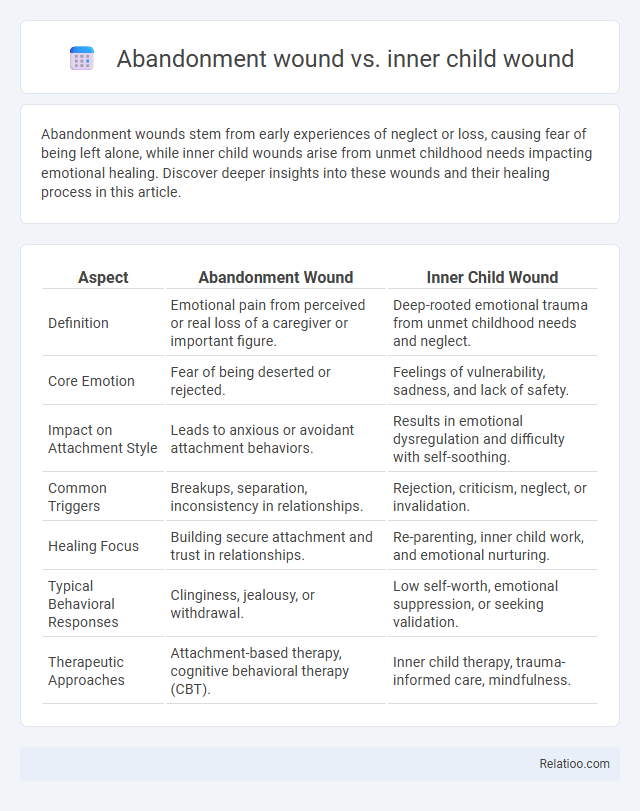Abandonment wounds stem from early experiences of neglect or loss, causing fear of being left alone, while inner child wounds arise from unmet childhood needs impacting emotional healing. Discover deeper insights into these wounds and their healing process in this article.
Table of Comparison
| Aspect | Abandonment Wound | Inner Child Wound |
|---|---|---|
| Definition | Emotional pain from perceived or real loss of a caregiver or important figure. | Deep-rooted emotional trauma from unmet childhood needs and neglect. |
| Core Emotion | Fear of being deserted or rejected. | Feelings of vulnerability, sadness, and lack of safety. |
| Impact on Attachment Style | Leads to anxious or avoidant attachment behaviors. | Results in emotional dysregulation and difficulty with self-soothing. |
| Common Triggers | Breakups, separation, inconsistency in relationships. | Rejection, criticism, neglect, or invalidation. |
| Healing Focus | Building secure attachment and trust in relationships. | Re-parenting, inner child work, and emotional nurturing. |
| Typical Behavioral Responses | Clinginess, jealousy, or withdrawal. | Low self-worth, emotional suppression, or seeking validation. |
| Therapeutic Approaches | Attachment-based therapy, cognitive behavioral therapy (CBT). | Inner child therapy, trauma-informed care, mindfulness. |
Understanding the Abandonment Wound
Understanding the abandonment wound involves recognizing deep emotional pain resulting from feelings of being neglected or rejected, often during childhood, which differs from the inner child wound that encompasses broader unmet emotional needs. The abandonment wound specifically triggers fears of loss and insecurity linked to attachment disruptions, impacting your ability to form trusting relationships. Healing this wound requires awareness of its origins and intentional practices to rebuild self-worth and emotional safety.
Defining the Inner Child Wound
The inner child wound refers to the deep emotional pain stemming from unmet childhood needs and unresolved trauma, affecting adult behaviors and relationships. Unlike abandonment wounds, which specifically arise from feelings of being left or rejected by caregivers, the inner child wound encompasses a broader spectrum of childhood emotional neglect or abuse. Healing the inner child wound involves recognizing and nurturing the vulnerable aspects of oneself created during early formative years.
Key Differences Between Abandonment and Inner Child Wounds
Abandonment wounds stem from feelings of being left or rejected, often triggered by specific events like parental absence or neglect, resulting in fears of loss and insecurity. Inner child wounds encompass broader childhood emotional traumas, including neglect, abuse, or unmet needs, affecting self-worth and emotional regulation throughout life. The key difference lies in the abandonment wound's focus on separation trauma and fear of desertion, while inner child wounds involve a wider spectrum of unmet emotional development affecting attachment and identity.
Origins and Causes of Abandonment Wounds
Abandonment wounds originate from early experiences of neglect, loss, or rejection, often during childhood, when a caregiver's absence or emotional unavailability creates deep feelings of insecurity and fear. Inner child wounds stem from unmet emotional needs or trauma experienced in childhood, affecting your self-worth and emotional regulation throughout life. Understanding the origins of abandonment wounds requires recognizing how these early relational disruptions impact your attachment patterns and emotional responses to loss or separation.
How Inner Child Wounds Develop
Inner child wounds develop from early emotional neglect, trauma, or unmet needs during childhood, leaving lasting imprints on your sense of self-worth and emotional security. Unlike abandonment wounds, which specifically arise from physical or emotional loss such as parental absence, inner child wounds encompass a broader range of emotional deprivation and inner conflict. Understanding the origins of these wounds is essential in healing and fostering emotional resilience.
Common Signs of Abandonment Wounds
Common signs of abandonment wounds include intense fear of rejection, difficulty trusting others, and emotional hypersensitivity to perceived neglect. These wounds often manifest as inner child pain, where unresolved childhood experiences trigger feelings of loneliness and insecurity in adult relationships. Abandonment wounds can overlap with inner child wounds but are specifically characterized by patterns of anxiety and clinginess linked to early separation or loss.
Recognizing Symptoms of Inner Child Wounds
Recognizing symptoms of inner child wounds often involves identifying feelings of deep-seated fear, insecurity, and emotional vulnerability rooted in early childhood experiences. These symptoms can include difficulty trusting others, a pervasive sense of unworthiness, and emotional triggers that seem disproportionate to current situations. Unlike abandonment wounds, which specifically arise from experiences of neglect or rejection, inner child wounds encompass a broader range of unresolved childhood emotions that affect adult behavior and relationships.
Emotional Impacts: Abandonment vs. Inner Child Wounds
Abandonment wounds typically trigger intense feelings of rejection, fear of being left alone, and mistrust in relationships, often stemming from early separation or loss experiences. Inner child wounds involve deep-seated emotional pain linked to unmet childhood needs, such as neglect or emotional unavailability, resulting in persistent vulnerability, low self-worth, and difficulty regulating emotions. While both wounds impact attachment and emotional security, abandonment wounds primarily evoke anxiety around loss and abandonment, whereas inner child wounds influence core beliefs and self-identity formed during developmental years.
Healing Approaches for Abandonment Wounds
Healing approaches for abandonment wounds emphasize creating a safe, consistent environment through therapy methods like attachment-based therapy and EMDR to process trauma and rebuild trust. Inner child work facilitates healing by reconnecting with unmet childhood needs and nurturing the wounded self through guided visualization and expressive arts. Combining cognitive-behavioral techniques with mindfulness practices helps individuals reframe negative beliefs and develop emotional resilience specific to abandonment trauma.
Inner Child Healing Techniques and Practices
Inner child healing techniques focus on addressing emotional wounds from childhood, including abandonment wounds that stem from neglect or loss. These practices often involve guided visualization, journaling, and self-compassion exercises designed to nurture and reparent your inner child. By specifically targeting abandonment wounds, inner child healing fosters emotional resilience and helps dissolve patterns of fear and insecurity rooted in early experiences.

Infographic: Abandonment wound vs Inner child wound
 relatioo.com
relatioo.com